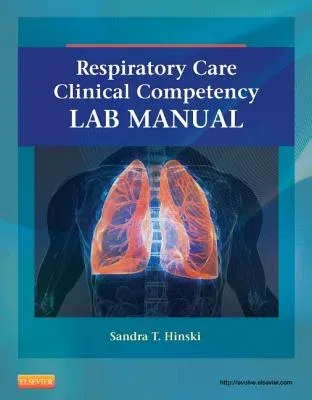Sandra T Hinski
(Author)Respiratory Care Clinical Competency Lab ManualPaperback, 20 December 2013


Description
Respiratory Care Clinical Competency Lab Manual provides the practical skills needed to apply classroom theory to clinical practice. This text has the flexibility to be used in conjunction with all other respiratory care titles, as well as in other disciplines that require competencies in respiratory therapy. With detailed, step-by-step procedures, supporting procedural illustrations, hands-on lab exercises, case studies, and critical thinking questions, this text helps you understand and apply theoretical knowledge by demonstrating specific skills. Procedural competency evaluation forms help you to assess your progress and performance of specific procedures.
-
Detailed, structured lab activities provide hands-on opportunities to assess psychomotor and patient communication skills in a controlled environment.
-
Content correlation to NBRC combined CRT/RRT exam content outlines helps you better prepare for credentialing exams.
-
Step-by-step procedural competencies prepare you for the RT competency areas established by the American Association of Respiratory Care (AARC) and meet the national practice standards for patient care.
-
Up-to-date coverage of current technology, equipment, Clinical Practice Guidelines (CPGs), CPR guidelines, and CDC recommendations, and mass casualty/disaster management equips you with the most state-of-the-art training for respiratory care.
-
Integration of case-based questions within the lab activities helps you develop and promote your critical thinking abilities.
-
UNIQUE! Coverage of polysomnography addresses clinical evaluation in this expanding specialty area.
-
Over 200 images provide visual guidance on how to perform procedures.
-
UNIQUE! Reality Check boxes arm you with practical knowledge on real-world application of various procedures.
-
UNIQUE! Tip boxes supply you with helpful pointers for the clinical arena.
-
Glossary of terms offers quick reference to terms presented in the text.
-
Up-to-date coverage of current technology, equipment, Clinical Practice Guidelines (CPGs), CPR guidelines, CDC recommendations, and mass casualty/disaster management will make this text the most current resource.
-
Detailed, structured lab activities will be designed to provide hands-on opportunities to assess psychomotor and "patient" communication skills in a controlled environment.
-
Integration of case-based questions within the lab activities develop and promote critical thinking in a clinical application.
-
UNIQUE! Coverage of polysomnography provides clinical evaluation in this expanding specialty that is part of a required competency area.
-
Chapter pedagogy will provide a standard format to include a chapter introduction, learning objectives tied to competencies, key terms, case-based critical thinking questions, laboratory exercises relevant to the content, clinical performance evaluation form(s), and procedural competency evaluation form(s). This pedagogy will help the student identify and focus on key content.
-
Step-by-step procedural competencies will cover the RT competency areas established by the American Association of Respiratory Care (AARC) and will meet the national practice standards for patient care.
-
Clinical performance evaluation form(s) will document observations and data collection performed during the lab exercise.
-
Procedural competency evaluation form(s) will give the educator the opportunity to measure and document the students' theoretical understanding and ability to apply this understanding by correctly performing a specific procedure.
-
Over 200 images illustrate instructions, giving students the visual guidance on how to perform a procedure.
-
Reference to the content in Egan's 10e will be included to provide a basis for the theoretical knowledge, when necessary.
-
Glossary of terms will provide a quick alpha reference of terms presented in the text.
-
Content correlation to NBRC combined CRT/RRT exam matrices help students to better prepare for the credentialing exams.